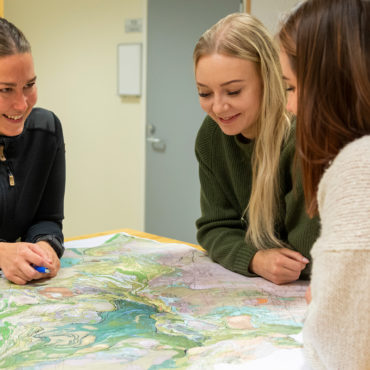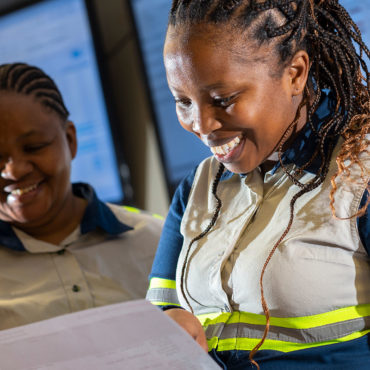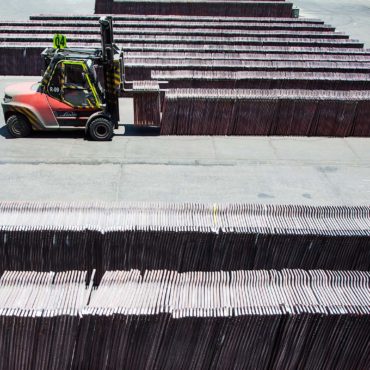Consolidated Mining Standard Initiative (CMSI)
What is the CMSI?
The Consolidated Mining Standard Initiative (CMSI) is a collaboration between The Copper Mark, ICMM, Mining Association of Canada (MAC) and World Gold Council (WGC) to consolidate their different responsible mining standards into one global Standard and multi-stakeholder oversight system.
The vision is for a sustainable society, enabled by the responsible production, sourcing, and recycling of metals and minerals. Through this Initiative, we are aiming to simplify the current mining standards landscape and promote continual improvement of environmental, social and governance practices along individual metals’ value chains.
Why are the Initiative Partners doing this work?
Responsible mining standards play an important role in giving stakeholders confidence that metals and minerals are being produced responsibly. Over the last 20 years we have seen a plethora of these Standards being developed, including those of the Consolidated Mining Standard Initiative’s (CMSI) Partners.
The CMSI responds to clear signals received from investors, civil society, customers, policy makers and mining companies that the existing standards landscape has become too complex – inconsistent for stakeholders seeking assurances that metals and minerals are being responsibly produced and too challenging and distracting for operators.
Our vision is for a sustainable society, enabled by the responsible production, sourcing, and recycling of metals and minerals. Through this Initiative, we are aiming to simplify the current mining standards landscape and promote continual improvement of environmental, social and governance practices along individual metals’ value chains.
How will this proposed Standard differ from existing standards?
We aim to simplify the existing landscape by consolidating the attributes of the World Gold Council’s Responsible Gold Mining Principles (RGMPs), ICMM’s Mining Principles, MAC’s TSM and The Copper Mark Risk Readiness Assessment Criteria Guide (jointly owned with the Responsible Minerals Initiative) into one standard. An important feature of the Standard is that it is applicable to any facility, anywhere in the world that is committed to responsible practices.
The Standard builds on the best attributes of the Partners’ individual standards. The decision to develop an approach based on three performance levels – Foundational Practice, Good Practice and Leading Practice, reflects a move away from the existing standards and has required careful consideration. In many cases, setting out expected performance at each of these levels has built on the current requirements of the existing standards. In addition, the approach to assurance and governance builds on existing standards to put forward a new approach that reflects current expectations from stakeholders.
Once finalised, the Standard is expected to be used by existing members and participants of our four organisations. This broad adoption would give the Standard the widest coverage of any voluntary mining standard to date with implementation anticipated to include almost 100 mining companies across approximately 600 facilities in almost 60 countries.
How can owners of other responsible sourcing standards engage in this process?
Owners of other responsible sourcing standards can engage in this process through the two public consultations on our portal. The first public consultation is now closed and feedback will be summarised and published in a consultation report in due course. The feedback will guide updates to the Standard and oversight system that will be shared for a second round of public consultation in 2025. Subscribe to our newsletter to receive updates on the next stage of the process.
Who is involved in this process?
The Partners — ICMM, WGC, MAC and the Copper Mark. Experts within these organisations are leading the drafting of the standard. The four Partners are governed by their four respective Boards.
The process has been guided by two advisory groups: one comprising industry representatives, and the other bringing together a diverse range of voices from stakeholders, including NGOs, investors, Indigenous groups, downstream customers and multilateral organisations.
Members of the Industry Advisory Group are participating in the Initiative as representatives of their organisations, while members of the Stakeholder Advisory Group are participating in their individual capacities as experts in their field. A full list of participants can be found here.
What is the role of the Industry and Stakeholder Advisory Groups?
The role of the Advisory Groups is to guide the CMSI Partners in the development of the Standard, assurance Process, reporting and claims policy, and governance model. They have met regularly over the last year and provided extensive input at different stages. While these two groups are structurally separate, functionally they are integrated and have met together.
Does this mean these advisory group members have ‘endorsed’ this process or the resulting consolidated standard?
No. Participation in the Stakeholder Advisory Group reflects the desire to shape the process and should not be interpreted as an endorsement of the outcomes.
Members of the Stakeholder Advisory Group, in their individual capacity, and the Industry Advisory Group have provided their support to move forward to the first round of public consultation. This is not an endorsement of the content of the consultation documents. Instead, it signals the Advisory Groups’ collective sense that the documents represent a sufficient basis for soliciting further feedback through a proactive, open, inclusive and transparent public consultation process to help shape the content of the next drafts to be consulted on at a later stage.
While members of the Stakeholder Advisory Group have expressed their support to move forward to the first round of public consultation, they retain the right to express concerns, which will be transparently disclosed at the end of the process. The Terms of Reference for the groups can be found here.
Public Consultation
What is being shared for public consultation?
The first public consultation closed on 16 December 2024. Feedback was collected from all interested stakeholders and rights holders on the draft Standard, assurance process, reporting and claims policy, and governance model.
The feedback will guide updates to the Standard and oversight system that will be shared for a second round of public consultation in 2025. Subscribe to our newsletter to receive updates on the next stage of the process.
How can I provide feedback?
The first public consultation is now closed, and feedback will be summarised and published in a consultation report in due course. For full transparency, the individual consultation responses will also be publicly available with the permission of those consulted.
The feedback will guide updates to the Standard and oversight system that will be shared for a second round of public consultation in 2025. Subscribe to our newsletter to receive updates on the next stage of the process.
How long will the Public Consultation last for?
Guided by ISEAL’s Codes of Good Practice, the development of the global Standard includes two rounds of broad public consultation. Launched on 16 October 2024, the first consultation will last for 60 days, ending on 16 December 2024. A second shorter consultation will be held in 2025. All interested stakeholders and right holders wishing to take part in the public consultation are invited to provide their feedback before the closing date through the CMSI portal. Subscribe to our newsletter to receive updates on the next stage of the process.
How will my feedback be used? And how will it be disclosed?
The development of the Standard includes two rounds of broad public consultation, providing an opportunity for all interested stakeholders to share their feedback and help shape the content of the Standard and related aspects. After each round of public consultation, a third party is responsible for cataloguing the feedback submitted and developing a consultation report (which will be published) that lays out the methodology, key statistics on who responded and a summary of feedback received including issues or concerns raised. In addition, for full transparency, the individual consultation responses will also be publicly available with the permission of those consulted.
Technical questions
Can the Standard be applied to small-cap companies?
Yes. The draft Standard comprises of 24 Performance Areas with requirements grouped into three distinct levels: foundational, good and leading practice. Foundational Practice is a starting point for conformance with minimum industry standards on which a facility can build on and improve their performance over time. It is an ‘entry point’ for companies who are committed to transparency and responsible mining practices and will need additional time or resources to reach Good Practice. The draft Standard is designed to provide a framework for companies to follow, supporting companies of all sizes who are interested in improving their performance and transparency.
Can the Standard be applied to companies focusing on exploration?
Some performance areas are especially relevant to exploration, notably number 4 on New Projects, Expansions and Resettlement. However, almost all the performance areas have aspects that are relevant to companies involved in exploration, as they set out the practices that responsible mining companies ought to follow at any stage of the mining life cycle. Failure to establish sound practices with respect to Indigenous Peoples, biodiversity, local communities or many other performance areas from the outset runs contrary to establishing a foundational basis for responsible mining practices. However, the systems and processes in place during exploration are unlikely to be sufficiently mature to demonstrate conformance to Good Practice level, nor may the resources be available to do so. Additionally, the assurance process is built to be applied at operational facilities and assurance could only take place once the facility is up and running.
What level of assurance will be required?
The proposed assurance process clearly lays out the detailed expectations of assurance providers. At the completion of the assurance process, the assurance provider will prepare an assurance report that clearly presents the facility level assured ratings for each Performance Area included in the scope of the assurance. The assurance report must be produced using the template in the assurance process. The website of the Standard will include the assured ratings as well as the assurance report for each facility that has undergone assurance.
Facilities must demonstrate continued performance through a full re-assessment every three years. At the three-year anniversary of the previous commencement date (i.e. the date on which the facility and the Secretariat entered into an agreement), the process is presumed to start again.
Please refer to the draft assurance process for details here.
Will the Standard apply at the facility or the corporate level?
The Standard is designed for implementation principally at the facility level. However, there are also requirements aimed at the corporate level (Performance Area 1: Corporate Requirements, and subsections of Performance Area 8: Diversity, Equity and Inclusion and Performance Area 20: Climate Change). It is acceptable to implement a corporate level requirement at the facility level (and vice-versa) as long as the requirement is fully met (and can be verified by an assurance provider). An example of a corporate requirement which could be completed at the facility level is the disclosure of mineral revenues (Performance Area 1, requirement 1.3). An example of a facility requirement which could be completed at the corporate level is the supply chain due diligence system (Performance Area 3.1). Many of the corporate-level requirements, however, cannot be fully implemented at the facility level and therefore require implementation at the corporate level.
What stages of the mine life cycle will it apply to?
The Standard is designed for implementation principally during the operational phase of a mine life. There are important performance areas and individual requirements throughout the Standard, however, which require implementation at the pre-operational phase of a mine life (including Performance Area 4: New Projects, Expansions and Resettlement, Performance Area 12: Stakeholder Engagement, Performance Area 14: Indigenous Peoples, etc.). While some requirements in these Performance Areas may not apply if the facility has passed the relevant stage of the mine life (i.e. they cannot be applied retrospectively), the Standard includes requirements covering the same topics (such as managing ongoing adverse impacts) during the operational phase. It should also be noted that a number of the requirements in Performance Area 24: Closure are to be applied during the operational phase of the mine (or earlier).
Do implementing companies have to implement all Performance Areas?
At the top of all 24 Performance Areas there is a brief description of the applicability of that Performance Area. Some Performance Areas are not applicable due to the specific nature, location or context of the facility. For example, if a facility does not have a Resettlement programme and Indigenous Peoples are not present, then section 2 of Performance Area 4 and all of Performance Area 14, respectively, are not applicable. Similarly, section 2 of Performance Area 23: Circular Economy is applicable to smelters only. Certain Performance Areas also have applicability “screens,” which require the facility to assess whether certain conditions are met to determine applicability.
See for example section 2 of Performance Area 3: Responsible Supply Chains (3.2 Mineral sourcing) and Performance Area 11: Security management. In all cases, the rationale for the facility’s determination of non-applicability will need to be verified by the assurance provider, based on evidence provided by (and discussions with) the facility during the assurance process, and publicly disclosed in the assurance report.
What is meant by “Conditional” Requirements?
The Standard also includes a number of individual requirements which apply only if certain conditions are met. For example, Performance Area 11: Security Management “If the facilities security is provided by a public security provider, put in place…” or Performance Area 15: Cultural Heritage “Where there is a risk of adversely impacting cultural heritage, conduct…”. These conditional requirements are not applicable if the conditions are not met. In addition, there are a number of requirements for which it is not possible to pre-determine the specific conditions related to applicability given the varied context in which the Standard is applied. Terms like “as necessary”, “where feasible” and “where possible” are therefore used, albeit sparingly, throughout the Standard. In all cases, the facility’s determination as to whether the requirement is applicable will need to be verified by the assurance provider, based on evidence provided by (and discussion with) the facility and its stakeholders during the assurance process.
How would companies report performance against the Standard?
The ‘scores’ for the Standard would be reported at the Performance Area Level as per the proposed reporting template (see the assurance process for details). There would be no aggregate single “score” provided for a facility. Given the number of applicable Performance Areas, requirements will not be the same for every facility, care should be taken when trying to compare if comparisons of scores between sites are made.
Is there a Glossary or interpretive guidance?
Words and phrases which are italicised in the Standard are included in the glossary and interpretive guidance section at the end of each Performance Area. Page 5 includes several key overarching terms to assist with the review of the Standard.


